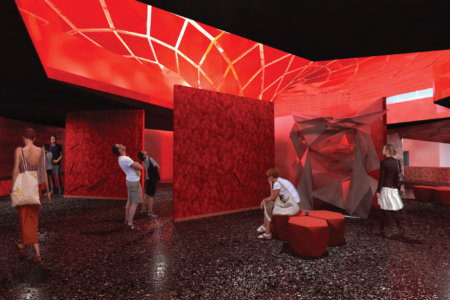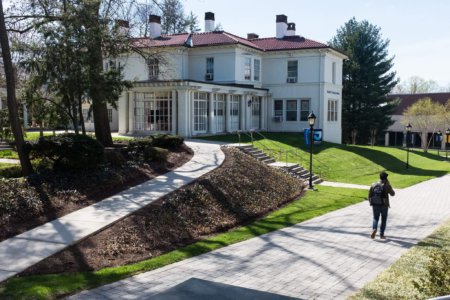Nothing represents society like architecture. Striking structures, multigenerational homes, and historical buildings all make up the fabric of a city, laced with endless information about the people who inhabited these spaces long before we did. Preserving these treasures and strategizing new ones that will be relevant and useful to future generations will always be important. It’s no easy feat — however, anything is possible with the right education.
To achieve one, look no further than Thomas Jefferson University. Its College of Architecture and the Built Environment is on a mission to educate a new generation of architecture, design and construction professionals — ones capable of creating an equitable and sustainable future.
Saying we “need” them is an understatement. With the World Economic Forum estimating nearly 70% of the world’s population living in cities by 2050, our world is, more than ever, dependent on people who want to build better surroundings. More importantly, we need individuals with the capacity to envision it before realizing it — think buildings, structures, environments and experiences that have never existed before; inclusive spaces for all or places for children to play.
Jefferson CABE graduates have the power to do it all. There are many reasons why world-changing aspirants from all over the world should follow in their footsteps, but five stand out the most.
A world-class reputation
Accreditation speaks volumes and five Jefferson CABE programs boast one of the nation’s most excellent. The Bachelor of Architecture, the Master of Architecture, the Bachelor of Landscape Architecture, the Bachelor of Science in Interior Design and the Bachelor of Science in Construction Management are all accredited by the National accrediting boards of their respective discipline.
Alumni and teachers rack up accolades of their own to maintain the legacy of the institution they know and love. Students often follow suit.
For example, Amy Leigh Hufford was named The Student of the Year by the International Interior Design Association, Stephanie Leigh Ziegler and Scott Murphy were named finalists in The John Stewardson Memorial Design Competition. Similarly, Christian Kaulius was a finalist in New York City Mayor Michael Bloomberg’s Reinvent Payphones Design Challenge. Such achievements are typical of Jefferson CABE learners.
CABE dean Barbara Klinkhammer confirms this, stating: “Most recently, our students have been awarded in a number of design competitions: Department of Energy Race to Zero Competition, American Society of Landscape Architects (ASLA) student competition, IIDA Awards, John Stewardson Memorial Fellowship in Architecture, and more.”
Every architectural aspiration is welcomed
Jefferson CABE is home to several curricula that emphasize specialized knowledge unique to each discipline. Each is paired with an emphasis on interdisciplinary collaboration to ensure every learner is prepared to add value in the global marketplace.
Its graduate offerings include a Master of Architecture, MS in Architecture, MS in Construction Management, MS in Geospatial Technology for Geodesign, MS in Historic Preservation, MS in Interior Architecture, MS in Real Estate Development, MS in Sustainable Design, Master of Urban Design — Future Cities, as well as the PhD in Architecture and Design Research. An extensive lineup of Accelerated Dual Degree Programs is also waiting to be explored by learners with specific, yet diverse aspirations.
Experiential learning at its finest
When it comes to applying knowledge, opportunities abound at the CABE. Jefferson’s strategic partnerships with major corporations, local communities and non-profit organizations play pivotal roles in ensuring students evolve into household names well before graduating.
Little wonder why US News and World Report ranked Jefferson among “10 National Universities Where Grads Are Paid Well”.
Where world-changing discoveries are made
For learners keen on exploring new and exciting ways they can make an impact on the world of architecture, they could pop into a Jefferson CABE research centre — where expert discoverers are ever-willing to share valuable insights.
The CABE is home to five: The Institute for Smart and Healthy Cities, Lab for Urban and Social Innovation, Center for the Preservation of Modernism, Malawi Health and Design Collaborative, and the Synesthetic Research and Design Lab.
PhD in Architecture and Design Research students are key contributors in these cutting-edge spaces. This STEM-designated program focuses on anticipating and shaping the future of architecture by creating new avenues of investigation, expanding knowledge bases, and solving time-sensitive, contemporary issues across the discipline. In the process, scholars will mastermind new insights into the past, present, and future of the field.
The living laboratory of Philadelphia
Located in bustling Philadelphia, Jefferson CABE is filled with both inspiration and opportunities. The US’s first “World Heritage City” is bursting with buildings from the 1700s and the oldest inhabited streets; hence why countless design and construction organizations have opted to set up shop here.
Furthermore, Philadelphia’s neighbouring cities include New York, Baltimore, Washington, Virginia Beach and more, expanding the range of work opportunities available to Jefferson students.
Follow Thomas Jefferson University on Facebook, Twitter, Instagram and YouTube













